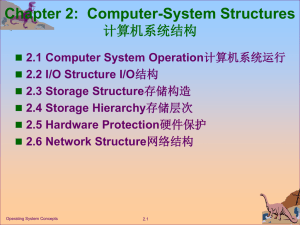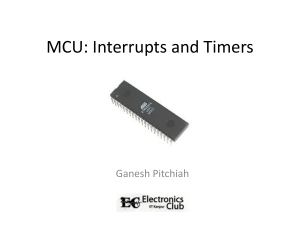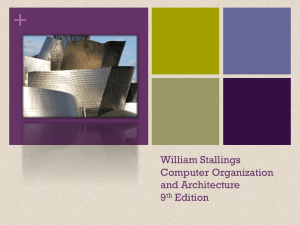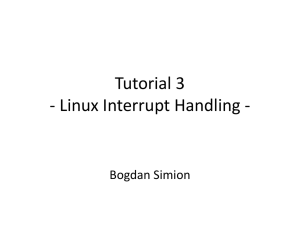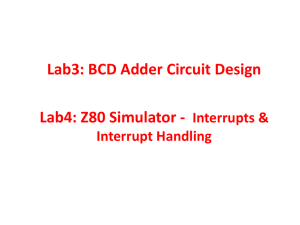03_io_software
advertisement
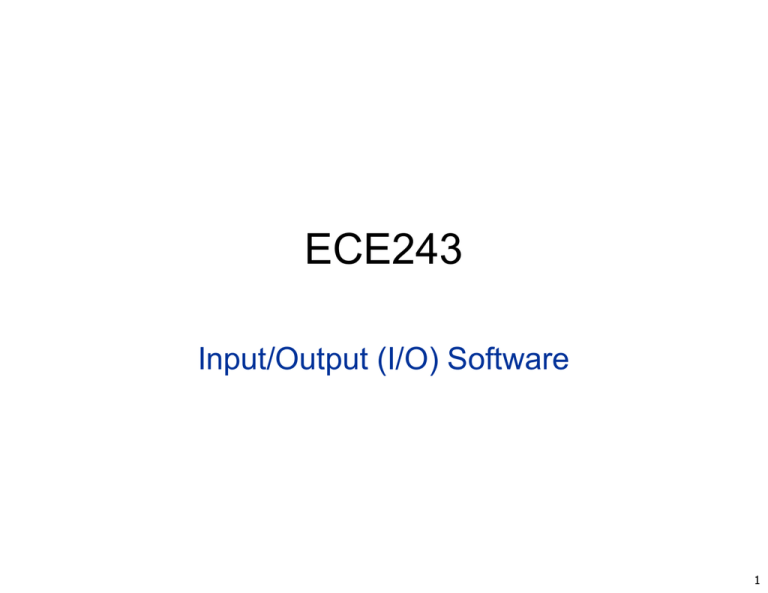
ECE243 Input/Output (I/O) Software 1 ECE243 Memory Mapped Devices 2 Connecting devices to a CPU • memory is just a device • CPU communicates with it – through loads and stores (addrs & data) • memory responds to certain addresses – not usually all addresses • CPU can talk with other devices too – using the same method: loads and stores • devices will also respond to certain addrs – addrs reserved for each device Dev1 Mem Dev2 bus store load CPU 3 MEMORY MAPPED I/O • a device: – ‘sits’ on the memory bus – watches for certain address(es) – responds like memory for those addresses – ‘real’ memory ignores those addresses • the memory map: – map of which devices respond to which addrs 4 DESL NIOS SYSTEM MEM MAP 0x00000000: 8MB SDRAM (up to 0x007fffff) 0x10001000: JTAG UART 0x10001020: 7 segment display 0x10000060: GPIO JP1 0x10000070: GPIO JP2 0x10003050: LCD display • These are just a few example locations/devices • see DESL website: NiosII: Reference: Device Address Map for full details 5 TALKING WITH DEVICES Dev2 Dev1 Mem bus cache ldwio stwio ldw stw CPU • Note1: use ldwio and stwio – to read/write memory mapped device locations – io means bypass cache if it exists (more later) • Note2: use word size even if it is a byte location – potentially funny behaviour otherwise •see DESL website: NiosII: Devices for full specs on every device 6 7-Segment Display • base: HEX3-Hex0: 0x10000020 HEX7-HEX4: 0x10000030 • Controls the individual ‘segments’ of the hex display • write only • handy for debugging,monitoring program status 7 7-Segment Display • base: HEX3-Hex0: 0x10000020 HEX7-HEX4: 0x10000030 Example: write the letter ‘F’ to 7seg display: 8 POLLING • devices often much slower than CPU – and run asynchronously with CPU – i.e., use a different clock • how can CPU know when device is ready? – must check repeatedly – called “polling” – asking “are you ready yet? Are you ready yet?…” 9 TIMER • like a stopwatch: – you set the value to count down from – can start/stop, check if done, reset, etc. • counts at 50MHz 10 TIMER: 7 6 5 4 3 2 1 0 .equ TIMER, 0x10002000 0(TIMER): bit1: 1 if timer is running bit0: 1 if timer has timed out (can write to 0) 4(TIMER): bit3: write 1 to stop timer bit2: write 1 to start timer bit1: write 0 to make timer stop when reaches 0 write 1 so timer starts over counting after reaches 0 8(TIMER): low 16bits of timeout period 12(TIMER): high 16bits of timeout period 11 Example: 5-second-wait • Do an action every 5-seconds using timer0 • First: must compute the desired timer period – recall: timer runs at 50MHz 12 Example: 5-second-wait . 13 INTERFACES • “serial” – means transmit one bit at a time – i.e., over a single data wire • “parallel” – means transmit multiple bits at a time – over multiple wires – more expensive • more$$$, wires, pins, hardware • which is faster? 14 GENERAL PURPOSE IO Interfaces • two parallel interfaces on DE2 – aka general purpose IO interfaces, GPIO – called JP1 and JP2 • each interface has: – 32 pins – each pin can be configured as input or output • individually! • pins configured as input default to 1 – called “pull-up” • pins configured as output default to 0 – default value of output register 15 GPIO LOCATIONS JP1: 0x10000060 JP2: 0x10000070 For each: 0(JPX): DR data register for in/out (32 bits) 4(JPX): DDR data direction register each bit configures data pin as in or out (32 bits) 0 means input, 1 means output 16 Example1 • configure JP1 as all input bits – and read a byte 17 Example2 • configure JP2 as all output bits – and write a character to the lowest 8 bits 18 Example3 • Example3: configure JP1 – lower 16bits input, upper 16 bits output, read then write it back 19 Serial Interfaces: • send/recv 1 bit at a time – in each direction • cheap – eg., only one data wire, plus a few control wires • can be very fast • ex: COM port on a PC, RS-232 is standard – Usually a nine pin connector – used to be very common in PCs – now replaced by USB – still very common in embedded systems 20 JTAG UART • JTAG: Joint Test Action Group – standard interface for test and debug for ICs – connects to host PC via USB blaster cable • UART: – Universal Asynchronous Receiver Transmitter – serial device • Asynchronous: – data can be sent/rec’d at any time • Example use: – keyboard/terminal I/O with NIOS 21 JTAG UART .equ JTAG_UART, 0x10001000 0(JTAG_UARG): data register: reading gets the next datum bit15: read valid bits7-0: data 4(JTAG_UART): control register: bits31-16: number of character spaces available to write 22 EXAMPLE: echo • read a character then send it back 23 OTHER DE2 MEM-MAPPED DEVICES • • • • • • • • • • slider switches push buttons LEDs LCD display RS232 UART audio codec VGA adapter ps2 connector (mouse) Digital protoboard see DESL www for full details 24 ECE243 Interrupts 25 WHEN IS A DEVICE IS READY • option1: polling – cpu keeps asking until ready – can be wasteful • option2: interrupt – cpu interrupted in the middle of what it is doing – a.k.a. exception 26 INTERRUPT BASICS 1. cpu ‘configures’ for interrupt – eg., device, memory, etc. 2. cpu does other work 3. cpu gets interrupted (can happen anytime) a) cpu saves its state b) cpu jumps to an “interrupt handler” c) cpu resumes what it was doing 27 Example Events handled by interrupts • • • • External Devices (ex UART, USB) OS: timers, disk I/O, keyboard I/O Debugging: breakpoints Program Errors (called “exceptions”) – Divide by zero – Misaligned memory access – Memory protection violation (segfault) 28 POLLING vs INTERRUPTS Polling Interrupt When? Difficulty Efficiency 29 SIMPLIFIED INTER. HARDWARE CPU Data DEV Addr Byte-Enables IRQ IACK • IRQ: interrupt request line – devices asserts to interrupt CPU • IACK: interrupt acknowledge – cpu asserts to acknowledge the device’s inter. 30 NIOS INTERRUPT SUPPORT • 32 IRQ lines – IRQ0 through IRQ31 • ctlX registers: – control registers – X=0,1,2,3,4 eg., ctl0, ctl3, etc. • r28 (ea): – exception return address • r24 (et): – exception temporary • 0x1000020: – addr (pc) of global interrupt handler code – only one for the system – eg., all interrupts jump to the same piece of code 31 EXAMPLE USE OF IRQ LINES: • • • • • • • • IRQ0: timer IRQ1: push buttons IRQ6: audio core IRQ7: ps/2 controller IRQ8: JTAG UART IRQ10: RS232 UART IRQ11: JP1 IRQ12: JP2 32 Relevant CTLX registers: • rdctl and wrctl – special insts allowed to read/write ctlx registers • ctl0: status register – bit0: PIE: processor interrupt enable bit – bit1: U: 1=user mode, 0=supervisor mode – you can only execute rctl/wctl insts in supervisor mode • ctl1: estatus register – holds copy of ctl0 when interrupt occurs • ctl3: ienable register – bits 31..0 enable IRQ lines 31..0 • ctl4: ipending register – each bit indicates a pending interrupt on IRQ lines 33 NIOS Interrupt Hardware Bit0 Bit31 ienable (ctl3) IRQ31 … IRQ0 ipending (ctl4) PIE bit (ctl0:bit0) Generate hardware interrupt 34 CONFIGURING AN INTERRUPT 1. configure device (various setup and enabling) 2. enable IRQ line (appropriate bit of ctl3) 3. enable external interrupts (PIE bit = bit 0 of ctl0) • Example: enable IRQ line 5: • Example: enable external interrupts: 35 ON A HARDWARE INTERRUPT: 1. current inst is aborted 2. addr of next inst is written to ea (skipped curr?) • • so know where to return when int. handler returns similar to ra, but reserved for interrupts 3. ctl1 = ctl0; (i.e., ctl0 is copied to ctl1) • so we can modify it, restore it to what it used to be 4. ctl0:PIE set to 0 • further interrupts are disabled 5. pc set to 0x1000020 • addr of global interrupt handler NOTE: these happen automatically in hardware! 36 Returning from an Interrupt • eret instruction: – does: ctl0 = ctl1; jmp ea – i.e., restores ctl0 (note: this renables pie bit) – jumps to exception return address • But ea is pointing to inst after the skipped inst! – awkward but necessary: must fix ea before returing EXIT_IHANDLER: subi ea,ea,4 eret 37 PLACING AN INTERRUPT HANDLER IN .s FILE . 38 MEMORY LAYOUT Addr 0x1000000 … 0x1000020 Value .section .reset advanced … .section .exceptions … … … .section .text … … … .section .data … … interrupt handler 39 GENERIC INTERRUPT HANDLER . 40 TIMER INTERRUPT SUPPORT • TIMER: 0x10002000 – 0(TIMER): write zero here to reset timer • and/or acknowledge an interrupt – 4(TIMER): bit0: write 1 to enable interrupts • Recall: 5-second delay: timer period = 0x0EE6 B280 upper lower 41 Ex: TIMER WITH INTERRUPTS . . 42 Ex: TIMER WITH INTERRUPTS . 43 OTHER DEVICES THAT SUPPORT INTERRUPTS • • • • • • • push buttons rs232 uart JTAG UART audio core ps/2 (mouse) DMA GPIO (JP1, JP2) see DESL:NIOSII:devices for details 44 MULTIPLE INTERRUPTS • HOW DO WE: – specify relative importance of interrupts • eg., priority – identify each interrupt • eg., which device did it come from? – allow nested interrupts • eg., allow an interrupt handler to itself be interrupted 45 Ex: GENERIC MULTIPLE INTERRUPT HANDLER • Goal: – handle IRQ 0 (timer) with higher priority than IRQ11 (JP1) • allow handler for IRQ11 to be itself interrupted – eg., nested interrupt trick: must save regs: ea, et, ctl1 46 Ex: Multiple Interrupt Handler . 47 Ex Cont’d . 48 FASTER DEVICE IDENTIFICATION • having a handler for every interrupt can be slow – worst case might check all devices • before finding interrupting dev. – what if there are 31 devices? • faster: – have hardware/cpu automatically ack device • when interrupt occurs – allow device to write an identifier on the data bus • when interrupt is ack’ed – can use the identifier to lookup a specific handler • for that device 49 EXAMPLE: 68000 interrupts • when interrupt ack’ed device – puts a ‘vector number’ on the databus • CPU automatically uses vector number – to compute an address in memory: – addr = vector_number * 4 • at that addr is stored – the addr of the start of that device’s handler • range of memory that vector numbers map to – is called the interrupt vector table (IVT) – a table of device-specific handler addresses 50 IF YOU RUN OUT OF IRQ LINES? IRQ CPU IACK DEV0 DEV1 IACK DEV2 IACK bus • SOLUTION: DAISY CHAIN: – – – – – have multiple devices share an IRQ line IRQ: any dev can assert, don’t know which did it IACK: pass along if not used by current device Identification: device puts vector number on data bus when ack’ed Priority: fixed: eg: left to right 51



